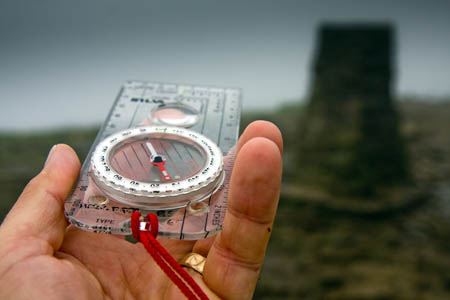Walkers in the far South-West of England are experiencing a phenomenon not seen for more than 200 years.
For the first time since Ordnance Survey, Britain’s official mapping agency, came into existence, magnetic North has shifted to the East of the national grid North.
Generations of outdoor fans have grown up with the knowledge that, for accurate navigation using a compass, the housing has to be moved a few degrees to the West when using a bearing from the OS grid.
Now, in a small area of England west of Penzance, the grid magnetic angle is slightly to the East.
The reason is that the magnetic force that attracts a compass needle constantly moves and, in Great Britain, has been heading gradually eastwards for a few years.
This year, the variation in the Penzance area is actually nil – no adjustment is necessary – and in the far reaches of Cornwall there is a small eastward movement to make.
It’s the first time since the mapping agency was founded in 1791 this phenomenon has happened.
The magnetic figures are supplied to Ordnance Survey by the British Geological Survey and vary depending on whereabouts in Britain you are. Most of England, Wales and Scotland still has a variation to the West of the grid, but this is slowly diminishing.
Outdoor enthusiasts can get information on magnetic variations for anywhere in Britain by keying in their location on the BGS website.
The earth’s magnetic field variations are due to fluid movements in its iron-rich core.

Nick Cable
22 January 2014Very interesting, stresses the importance of relating the terrain to the map as you travel the route! Picking off way markers as you go.
Personally speaking I am not overly concerned with 1 or degrees either way, you have to ask to do people accurately set the compass bezel perfectly, do they hold it perfectly level when reading it, especially when moving!
Add to that, are they wearing rings, jewellery, watches etc that may affect the needle point. Heaven forbid its on the top of a hunting knife or such like
Bernie Holdsworth
22 January 2014Could this be the cause of the weird weather we and other countries are having lately?
John K
22 January 2014No.
Neil
23 January 2014Haha!
Ian McBean
24 January 2014Bernie: that is clearly caused by large quantities of hot air emanating from people in Middle England reading the Daily Mail. It is known as the Apoplectica-Faragum Phenomena.
Michael Ferguson
30 January 2014I think this is why GPS navigation was developed. They new the poles were switching and magnetic navigation would be useless.